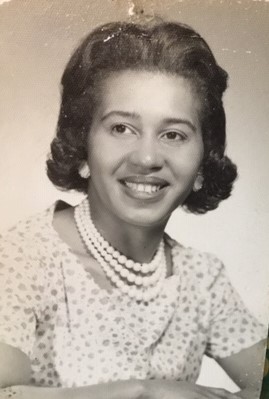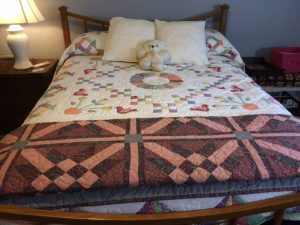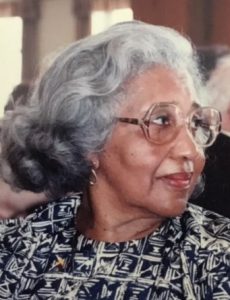1. Tell us a little information about yourself?

I am writing this story on behalf of my mother who passed away in March 2020. Clarissa Johnson Smith grew up in Woodstown, New Jersey as the only child of Jeanette and Ross Johnson. She and her husband, Earl Smith were married for 39 years and had three children Janell, Anthony, and Jeffrey. Earl and Clarissa were the proprietors of ServiceMaster by Earl Smith. In addition to running the family business, Clarissa was very active in her church and community (e.g., Sunday school teacher and fundraiser, co-leader of the youth arts & crafts, scouting, and 4-H programs, 20 year family health clinic volunteer).
Clarissa was also a woman of many passions. She loved traveling, shopping, and the arts, especially quilting, dressmaking, painting, and stenciling. A devoted family person, she regularly hosted family holidays and picnics, and documented family history. In fact, developing Myasthenia Gravis (MG) inspired her search into genealogy. Clarissa reflected in a family reunion booklet tracing her family lineage back to the 1840’s,

“I began this journey after I was diagnosed with Myasthenia Gravis as a means to see if it was present in our family history. However, I became more and more intrigued as I talked with our family, researched census and county records, and gathered information through Ancestry.com”…
Clarissa was diagnosed with MG about 18 months after she experienced increasing difficulties standing and walking. Although diagnosed at 80/81years of age, my mother’s symptoms most likely began when she was around 75. At that time there were occasional falls, which she attributed to clumsiness and brief periods where “her legs just wouldn’t work” and we attributed it to stress.

Following a serious MG flare and bout of pneumonia, at age 83, Clarissa moved to Pittsburgh to live with her daughter, son-in-law, and granddaughter. During this period, she had to regain strength in her upper body, re-learn swallowing and walking, and adapt to new health care providers, medical regiments, and living circumstances. However, by the next year she no longer needed a wheel chair, regularly attended Myasthenia Gravis of Southwestern Pennsylvania (MGSWPA) support group meetings, and joined the family church. Importantly, Intravenous Immunoglobulin (IVIG) treatments brought an increased normalcy to her life. Soon (age 84/85) she was walking and driving, belonged to three senior organizations within the church, two quilting and one genealogy club, and traveled regularly to New Jersey to visit family and friends.
Life with MG, even following serious MG complications in her 80’s, was active, vibrant, meaningful, and fulfilling. What made this possible?

- Faith, spiritual connection, always having hope
- Purpose (e.g., family/friend connections, ongoing learning and teaching, researching family history)
- The support of others who were invested in her health and well-being
- Family, friends, faith community, health care providers
- Participation in a support group to learn and share information and strategies and listen to questions raised by others with MG
- Medical professionals who listened to her needs and advocated on her behalf.
- For example, IVIG treatment was quite important but also very expensive. The MG Clinic advocated diligently to obtain payment for these treatments through medical insurance.
- Prioritizing
- Time to exercise, as able, to keep maintain muscle strength
- Doing the most important activities early in the day when energy was strongest.
- And as per my mother by her 70’s and 80’s “having young friends”.
During her nine and a half years in Pittsburgh she made many close friends and participated in a myriad of groups and activities. In the words of one dear friend, “Clarissa gave love and was so easy to love.” We thank God for the years we had with her and for the beautiful memories we will always hold close to our hearts.
2. How old were you when you were first diagnosed with MG?
Clarissa was approximately 81 years of age when she was diagnosed at the Hospital of the University of Pennsylvania in Philadelphia.
3. How long did it take to get your MG diagnosis?
Clarissa’s diagnosis occurred approximately 18 months after symptoms began occurring with greater frequency (approximately age 79). However, in looking back, my mother’s symptoms most likely began when she was about 75 years of age. Things started with occasional falls, which she attributed to clumsiness and progressed to very brief, intermittent instances in which she was unable to stand or walk.
4. What advice would you give to someone recently diagnosed with MG?
- Enlist the support of family and medical staff. Write down your questions in advance of appointments,
- Participate in a support group to learn and share information and strategies and listen to questions raised by others with MG.
- Keep brief notes to help you share what is happening with you and your care with your different medical providers.
- Always remain hopeful.
5. Are there any tricks/tips you use to manage your symptoms throughout the day?
- Prioritize your activities and engage in the most important ones at times when your energy is highest.
- As you are able, make time to do prescribed exercises to keep your muscles as strong as possible.
6. How has MG impacted your life?
a. Relationships with family, friends, co-workers?
Following a MG crisis and unplanned move to Pittsburgh, maintaining contact and communication with family and friends from the past was vitally important as was becoming engaged in new activities and forming new friendships. Support from family around medical and non-medical issues was critical, as was making time to simply have fun.
b. Other life decisions?
Continue spiritual growth, remain active and engaged, always continue learning, and make time to give back and help.
7. How has MG impacted your priorities and expectations in life?
It strengthened Clarissa’s commitments to spiritual growth, learning, remaining active and sharing knowledge with her fellow quilters. Developing MG was also the impetus for an initial search into similar symptoms in other family members, which in turn led to both sides of her family and her husband’s family trees.


